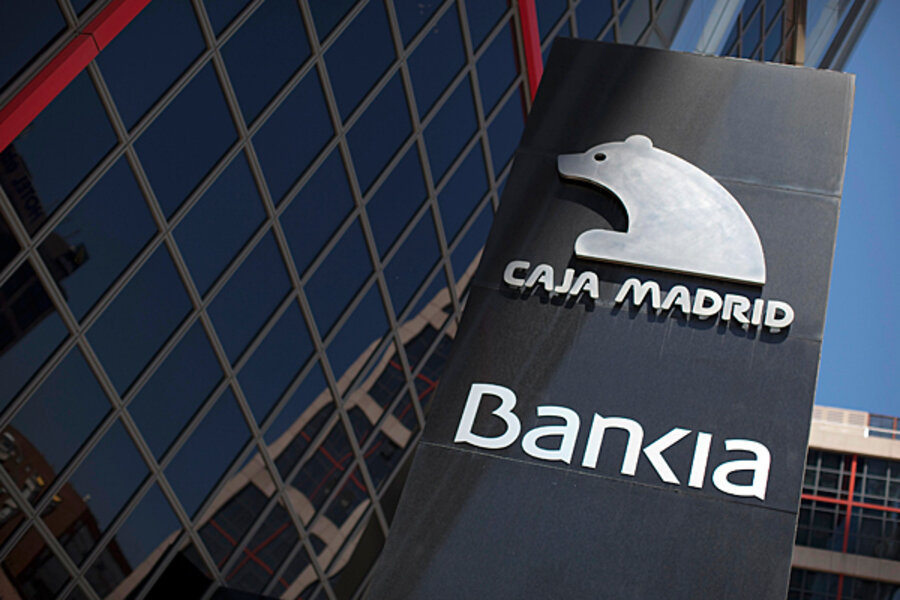As its banking woes mount, Spain ponders where to go from here
Loading...
| Madrid
When Spain’s government nationalized the Bankia bank last week, it set off a spiraling economic debacle that has brought the country to the brink of an embarrassing bailout. But some say the move could mark the beginning of the end of the painful economic crisis, because Spain can start recovering after hitting bottom or accept a plan to rescue its financial system.
“From a macroeconomic point of view, I think the Bankia crisis has to be understood as another stage, not the final one, to stabilize Spain’s financial system and to cleanse the real estate bubble,” says Josep Oliver, applied economics professor in the Universidad Autónoma de Barcelona. “It’s hurting many people, but this could actually be positive if this is the last chapter ... if we come out and everyone is convinced the contingencies are in place for worst-case scenarios, that the banks won’t be allowed to keep doing what they did, and that the resources will be made available somehow."
The crisis in the country's No. 4 bank is also Spain’s crisis. It’s rooted in the bursting real estate bubble in 2008, declining economic growth at home and globally, and unemployment that has hit 24 percent. Government efforts to reform banks' questionable practices were insufficient, designed more as temporary measures to win some time while the economy recovered. But it got worse, and European institutions, the International Monetary Fund, ratings agencies, and economists have long warned that the system would have to be cleansed sooner or later.
“Much of what we see in the banking sector is at least morally questionable," says Dr. Oliver. But, he adds, "the banks didn’t do it alone. The entire country mortgaged its future, not banks. We have to accept that we all went wrong, as a country.”
A crisis foretold
Bankia was born out of the merger of seven savings banks in the first financial reform in 2010, most of them indirectly controlled by the conservative Popular Party currently in power.
But their books, like those of most savings banks in Spain, were plagued with bad debts, not of homeowners, but of construction companies that went bankrupt when real estate collapsed. Bankia held 32 billion euros in real estate toxic assets.
The government-controlled board named Rodrigo Rato, a former IMF managing director, as well as former economic minister and vice-president of Spain with close ties to the ruling party, as chairman, and the bank went public in July 2011.
But the bank was crippled by huge losses from its credit business. When more recently the Spanish government tightened bank regulations to increase contingencies to cover toxic debts, Bankia could no longer hold out.
On May 7, the conservative government forced the resignation of Mr. Rato, and two days later it partially nationalized the bank. With new leadership, Bankia announced it would recast its 2011 results.
Bankia’s stock has lost around half of its value since, and it has dragged the shares of the entire financial sector, along with the country’s biggest companies, to almost decade lows.
The financial woes that will inevitably take billions to bail out, along with a shrinking economy and rising unemployment, pushed the cost of borrowing of Spain to a euro-era record high, to levels close to those of Greece, Portugal, and Ireland before they were bailed out.
Spain – echoing other countries that are now under international supervision – insists it won’t need to be rescued by its European peers.
Stock holders and clients of Bankia are both accusing the bank of fraud and the government of ineptitude. Worse, there are rumors of runs on banks that have diminished the little confidence that remained of a quick exit out of the crisis.
What’s next?
Bankia’s future is uncertain, although most see a similar bank failure in the 1990s as a precedent, and would involve breaking the bank into pieces and auctioning it off. Spain’s biggest banks, Santander and BBVA, which operate in Asia, America, and Europe, are struggling, but they are not as exposed to toxic assets and are significantly more capitalized to survive the storm.
But the bigger issue is Spain’s broader economic woes. Credit dried out years ago, the economy is in recession and will remain so for some time, unemployment is rising, and the government is implementing the biggest cuts in public spending in history, on top of those implemented by the previous government.
The government Friday for a second time this year announced a revision of the country's 2011 deficit as a percent of GDP after regional governments – controlled by the ruling party – reported much wider shortfalls.
The cost of borrowing for Spain also rose 25 percent this week in tandem with Bankia's troubles since last week. Lenders are asking Spain for almost 7 percent to lend it money in the form of 10-year sovereign bonds, an unsustainable rate if it holds for a long period that would inevitably trigger a bailout.
Spain, though, can do very little. Without more economic growth in Europe, without a clear exit strategy for the continent’s troubled economies, starting with Greece, there is little that can be done.
Spain needs affordable credit to recapitalize and secure its banks, but its troubled financial sector, coupled with European uncertainty, make that an unrealistic scenario. Without money, credit won’t trickle down, the economy will continue contracting and unemployment will continue rising, in a vicious circle that most can diagnose, but few can offer a solution for.
“I think the government acted responsibly [with the Bankia takeover]. With all this behind us, Spain can attract more credit, just like it happened in the US, the UK, and other European countries,” Dr. Oliver says. “But this is not just the banks. It’s all of us.”







